Super 8 film



Super 8mm film is a motion picture film format released in 1965[1][2][3] by Eastman Kodak as an improvement of the older "Double" or "Regular" 8 mm home movie format.
The film is nominally 8 mm wide, the same as older formatted 8mm film, but the dimensions of the rectangular perforations along one edge are smaller, which allows for greater exposed area. The Super 8 standard also allocates the border opposite the perforations for an oxide stripe upon which sound can be magnetically recorded.
Unlike Super 35, the film stock used for Super 8 is not compatible with standard 8mm film cameras.
There are several different varieties of the film system used for shooting, but the final film in each case has the same dimensions. By far, the most popular system was the Kodak system.
Super 8 system

Launched in 1965 by Eastman Kodak at the 1964-65 Worlds Fair, Super 8 film comes in plastic light-proof cartridges containing coaxial supply and take up spools loaded with 50 feet (15 m) of film, with 72 frames per foot, for a total of approximately 3,600 frames per film cartridge. This is enough film for 2.5 minutes at the professional motion picture standard of 24 frames per second, and for 3 minutes and 20 seconds of continuous filming at 18 frames per second (upgraded from Standard 8 mm's 16 frame/s) for amateur use. In 1973 the system was upgraded with a larger cartridge, which included film with magnetic sound. In 1975 an even larger cartridge, sA 200-foot (61 m) cartridge became available which could be used in specifically designed cameras. The sound and 200' cartridge system are no longer available, but the 50' silent cartridge system is still in manufacture. Historically, Super 8 film was a reversal stock for home projection used primarily for the creation of home movies. It became an extremely popular consumer product in the late 1960s through the 1970s, but was largely replaced in 1980 by the use of video tape. During the mid to late 1980s Super 8 began to re-emerge as an alternative method for movie production, beginning with its use in MTV Music Videos in 1981. In 1993 the company Super8 Sound, now called Pro8mm, pioneered the use of color negative in super 8 by custom perforating and loading a variety of 35mm film stocks into the Super 8 film cartridge.[4] This included emulsions from Kodak, Fuji and Ilford. Today Super 8 color negative film is the main color stock used. There are also Super 8 reversal films available including 200D Agfa color & B&W from Foma, Adox and Orwo & Kodak.

The Super 8 plastic cartridge is probably the fastest loading film system ever developed, as it can be loaded into the Super 8 camera in less than two seconds without the need to directly thread or touch the film. In addition, coded notches cut into the Super 8 film cartridge exterior to allow the camera to recognize the film speed automatically. Not all cameras can read all the notches correctly, however, and there is some debate about which notches actually deliver the best results.[5] Canon keeps an exhaustive list of their Super 8 cameras with detailed specifications on what film speeds can be used with their cameras.[6] Usually, testing one cartridge of film can help handle any uncertainty a filmmaker may have about how well their Super 8 camera reads different film stocks. Color stocks were originally available only in tungsten (3400K), and almost all Super 8 cameras come with a switchable daylight filter built in, allowing for both indoor and outdoor shooting.
The original Super 8 film release was a silent system only, but in 1973 a sound on film version was released. The film with sound had a magnetic soundtrack[7] and came in larger cartridges than the original cartridge in order to accommodate the sound recording head in the film path. Sound film requires a longer film path (for smoothing the film movement before it reaches the recording head), and a second aperture for the recording head. Sound cameras were compatible with silent cartridges, but not vice versa. Sound film was typically filmed at a speed of 18 or 24 frames per second.[8] Kodak discontinued the production of Super 8 sound film in 1997, citing environmental regulations as the reason because the adhesive used to bond the magnetic track to the film was environmentally hazardous.[9]
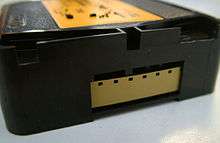
In 2005 Kodak announced the discontinuation of their most popular stock Kodachrome[10] due to the decline of facilities equipped with K-14 process. Kodachrome was "replaced" by a new ISO 64 Ektachrome, which used the simpler E-6 process. The last roll of Kodachrome was processed on January 18, 2011 (although announced last date of processing was December 30, 2010) in Parsons, Kansas, by the sole remaining lab capable of processing Kodachrome.[11] In December 2012, Kodak discontinued color reversal stock in all formats including 35mm and Super 8.
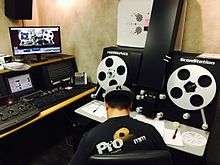
Today there is still a variety of Super 8 film stocks. Kodak has three Super 8 color negative stocks cut from their Vision 3 film series, ISO 50, 200 and ISO 500 which can be used in very low light. Kodak reformulated the emulsions for the B&W reversal stocks and made Tri-X (ISO 200) in order to give it more sharpness. Film cut to super 8 from other manufactured raw stock such as Fuji, Orwo, Adox, Agfa & Foma are also available. Pro8mm offers 7 color negative stocks made from Kodak & Fuji film. Color Reversal film for Super 8 is still available from several Super 8 specialty companies. Wittner Kinotechnik offers Super 8 made from a batch of Agfa Aviphot 200D which was perforated and slit for Super 8, 8mm and 16mm formats. This film is loaded into Super 8 and Single cartridges by several of the specialty company. Other stocks, such as the new Fuji reversal film, and existing supplies of Kodak 35mm 100D are often made available in Super 8 by these specialty companies. Here is a sample of New Provia in Super 8.[12] Kodak does not offer processing for any Super-8 films. There are many of other labs through speciality companies that offer different services and schedules so check on which does what and with what schedule. The largest of these labs are Pro8mm in Los Angeles, CA, USA and Andec in Berlin German, but there are also many regional labs that do Super 8 processing services including Cinelab in Massachusetts, United States; Movie & Sound in Florence, Italy; Retro 8 in Japan; Spectra Film & Video in Los Angeles; Reversal Lab in the Netherlands; Dwayne photo in the United States; and Film Rescue in Canada just to name a few.
The growing popularity and availability of non-linear editing systems has allowed film-makers and any user of film to shoot Super 8 film but edit in digital. This avoids much of the tedium of handling film and the damage to the film which can occur when editing the actual film. Super 8 films may be transferred (Scanned) to digital through a variety of processes, and then imported into computer-based editing & correction systems for post production. Today's systems can even scan super 8 to 4K digital in a variety of formats. Here is a sample of Super 8 Data Scanned to 4K.[13]
Fujifilm Single-8 system
Fujifilm of Japan developed an alternative format called Single-8, which was released in 1965 as a different option to the Kodak Super 8 format.
Single-8 cartridges without a press plate are of a different design from a Super 8 cartridge, resembling a cassette-style design (supply and take-up reels side by side) as opposed to Super 8's coaxial cartridge design (one reel on top of the other). Therefore, Single-8 film cartridges can only be used in Single-8 cameras. However, the film loaded in a Single-8 cartridge has exactly the same dimensions as Super 8 (though it is made of a thinner & stronger polyester base, rather than the acetate base of Super 8 film), and can be viewed in any Super 8 projector after processing. Fuji, however, recommended that only tape splices be used when combining Single-8 footage with Super-8, as cement would cause damage to the Single-8 footage. Also, when jammed, Single-8 footage had a tendency to stretch in the projector, unlike the acetate-based Super-8 film, which simply broke.
Although never as popular as Super 8, the format existed in parallel. On 2 June 2009 Fuji announced the end of Single-8 motion picture film.[14] Tungsten balanced 200 ASA Fuji RT200N ceased to be manufactured by May 2010. Daylight balanced 25 ASA Fujichrome R25N remained available until March 2012. Fuji's in-house processing service was available until September 2013.
Polaroid Polavision
An instant 8mm film released in 1977 by Polaroid, Polavision uses the same perforations as Super 8mm film. It can be projected through a Super 8mm projector if the film is transferred from the original cartridge to a 8mm reel. However, because of the additive process, the picture will be much darker.
Double Super 8
Double Super 8 film (commonly abbreviated as DS8) is a 16 mm wide film but has Super 8 size sprockets. It is used in the same way as standard 8 mm film in that the film is run through the camera twice, exposing one side on each pass. During processing, the film is split down the middle and the two pieces spliced together to produce a single strip for projection in a Super 8 projector. Because it has sprockets on both sides of the film, the pin-registration is superior to Super 8 film and so picture stability is better.
Max8
As super 8 progressed to be used in HD and Theatrical applications, a need arose for widescreen compatibility without having to use expensive optical adaptors or excessive cropping. Since magnetic sound-striped film is no longer available, the area of the film could be used for image and expand the picture aspect ratio in a process similar to the creation of Super 16 from 16mm. The creators of Sleep Always[15] experimented with widening the camera gate to expose into the sound track region to achieve this. The result was a negative that has 20% more usable picture when using Super 8 in wide screen application. In March 2005, Pro8mm introduced a more complete version of this widened gate and called it Max8.[16] Max8 is not only an expanded gate but also established a center viewfinder with frame marking to see how the image will appear in 16X9 space (HD TV). Here is a video explanation of this process.[17] Pro8mm sells Max-8 widescreen cameras, which are remade Super 8 cameras.[18] These cameras have an aspect ratio of about 1.58:1 (which among common aspect ratios is closest to 16:10 aka 1.6:1, and second-closest to 1.66:1 classic European widescreen aka 5:3 aka VistaVision), so less cropping is needed to convert the image to widescreen (especially 16:9 aka 1.77:1) than the traditional 1.33 ratio. All new Super 8 cameras have included Max8. Sample of Max8 production.[19]
In 2015, Logmar of Denmark made a one-off batch of 50 "digicanical" pro-level Super 8 cameras to celebrate the 50th anniversary of Super 8.[20]
In 2016, Eastman Kodak showed a concept[21] for a new Super 8 camera, its first such camera in over 30 years.[22][23]
Equipment and film
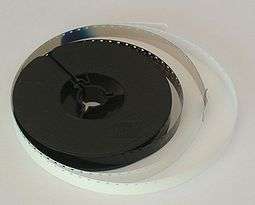
Equipment

Although Kodak launched Super 8 and had its own cameras, hundreds of other companies produced Super 8 Camera, Projection, Editing, and Sound Equipment. Some of the more notable companies that made Super 8 equipment include Canon,[24] Bauer,[25] Nizo,[26] Super8 Sound (Pro8mm),[27] Beaulieu, Leicina, Logmar, Ciro, Bolex, Goko, Hahnel, Wurker, Minolta, Minnette, Nikon.[28] Most of these companies had long histories in the production of motion picture equipment, dating back to the 1930s with 8mm. In 1980, the consumer market for Super 8 collapsed. Most of the independent companies were forced into bankruptcy or merged, as the demand for super 8 evaporated overnight. Many held the doors open until 1985, when many gave up completely on movie film equipment. A few re-emerged from these dark days of Super 8 including Beaulieu, who in 1985 introduced a new 7008 camera and Super 8 Sound that introduced a new version of its full-coat recorder, the Mag IV. The companies in which Super 8 was only a division simply closed. Kodak continued support for super 8. A few products re-emerged with new features such as crystal sync and Max8.[29] Several Canon models have also started to reappear as restoration efforts like the RhondaCam. Recently, new companies have started producing new super 8 cameras. In 2015, Logmar introduced a limited edition completely new Super 8 Camera,[30] and in 2016, Kodak showed a concept of a new Super 8 camera at the 2016 CES expo.[31] There are literally millions of Super 8 cameras that are still available and viable because of manufacturing methods back in the 1960s and 1970s. These cameras can be found at specialized retailers and distributors and at auction sites such as eBay.
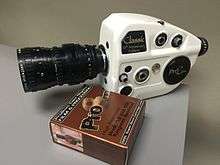
Film Stock
Kodak currently offers three of its latest Vision 3 color negative stock, the 50 D, 200T, and 500T in Super 8 along with its Trix B&W reversal film. Several Super 8 specialty companies (such as Pro8mm in Burbank CA, USA, Wittner Cinetec (in Hamburg, Germany) and Kahlfilm (in Brühl, Germany), slit & perforate raw 35 mm film stock from Kodak, Fuji, ORWO, Agfa, and Foma, then repackage it in Kodak Super 8 cartridges. Adox has its own B&W film supply and provides this in its own Super 8 cartridge design by GKfilmCinevia. Retro 8 of Japan provides a similar service for Super 8 film in the Fuji Cartridge (Single8 ). There are now more varieties of Super 8 film available than ever before.
Super 8 film is available worldwide through specialty shops and online from major companies such as Amazon. It has become common to see it sold with processing prepaid and for it to be sold with scan to digital services at a variety of different levels from Standard Definition Digital to 4K Data. It can even be purchased to include all the logistic associated with the process including film processing, scanning and internet delivery of image and mail in and back services. The Super 8 film kit.[32] This is a sample video done with the Super 8 film kit.[33]
Sound
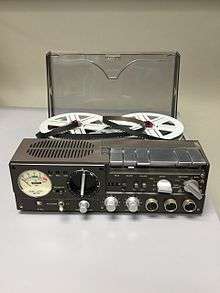
In the beginning 1965, super 8 was introduced as a silent format. Over time, several companies began to offer sync sound options for Super 8 filmmaking. Two companies introduced comprehensive sound systems for super 8. These were Super8 Sound Inc led by Harvard Film Professor Bob Doyle[34] and Optasound led by Richard Leacock at MIT. This is a video made by Kodak at Super8 Sound Inc about the Super8 Sound system[35] Double system, as it was called, when sound and picture are recorded separate, was great for more professional application and for education about film production, but for consumers this was simply too complex and expensive. So, in 1973, Kodak introduced magnetic recording on the actual super 8 film. The sound track was added on the edge of the film opposite to the perforations (see the illustration at head of the article). Standard 8mm had the stripe between the perforations and the edge of the film which made good contact with a magnetic head problematic. A balance stripe was added on the opposite edge to facilitate spooling of the film. Projectors, that could record and play sound, appeared before sound cameras. The sound was recorded 18 frames in advance of the picture (as opposed to 56 frames for standard 8mm). This short distance of just 3 inches facilitated the relatively compact size of the later sound cartridges. Some projectors used the balance stripe to provide a second channel and hence stereo sound.
Super 8mm was also specified with an optical sound track. This occupied the same location as the magnetic track. Picture to sound separation in this format was 22 frames. Projectors and cameras obviously could not record sound in this system, but optical sound package movies became briefly popular, particularly in Europe (mainly because they were cheaper to produce - though the projectors cost more). Although the optical sound should have been inferior in quality to magnetic sound (running at 3.6 inches per second for 24 frames per second), in practice it was often much better, largely because packaged movie magnetic sound was often poorly recorded.
Packaged movies
Although the 8 mm format was originally intended for creating amateur films, condensed versions of popular cinema releases were available up until the mid-1980s, for projection at home. These were generally edited to fit onto a 200 ft (61 m) or 400 ft (120 m) reel. Many Charlie Chaplin films, and other silent movies were available. The Walt Disney Studio released excerpts from many of their animated feature films, as well as some shorts, in both Standard and Super 8, some even with magnetic sound. New releases of material were not stopped by major studios until the mid-1980s in the U.S. Releases of trailers, shorts, and a few feature films still continues in the U.K.
In-flight movies
Starting in 1971[36] In-flight movies (previously 16 mm) were shown in Super 8 format until video distribution became the norm. The films were printed with an optical sound track (amateur films use magnetic sound), and spooled into proprietary cassettes that often held a whole 2-hour movie.
Popularity


Super 8 was most widely used for filming home movies. Over its history, which actually began with 8mm in 1932, billions of home memories have been preserved in motion pictures. Today amateur usage of Super 8 has been replaced by digital, but the format is still regularly used by artists, students and independent filmmakers. Super 8 is just another creative tool to use alongside other formats. Some seek to imitate the look of old home movies, or create a stylishly grainy look. Some want to create alternative looks for flashback sequences and altered states of consciousness. Some just like the idea of creating images in the classic style of using actual film. Super 8 is a relatively inexpensive film making it popular among filmmakers working on a low budget who still want to achieve the classic look of real film. Some of the more popular examples of this are music videos like Paula Abdul's "Straight Up", Madonna's "Erotica", Mazzy Star's "Fade Into You", and Mariah Carey's "All I want for Christmas is You". John Mellencamp's 2011 documentary film, It's About You, was shot entirely in Super-8.[37] Famous commercials such as the Nike "Revolution " campaign with the Beatles revolution soundtrack. Super 8 film has been used in commercials for Volvom. Volskwagon, The WB, Yamaha, Carls Junior, The Boston Celtic, The NBA, Whole Foods, Swiffer, Miracle Whip, The Dodgers, Dos Equis Beer (The most interesting man on earth), Burton, DC Shoes, McDonalds, Tory Burch, Tommy Hillfigure, Armani Sports,[38] just name a few. There are independent ultra low budget feature project from artist such as Derek Jarman, Dave Markey", Desperate Teenage Lovedolls & Love Dolls Superstar, Mark Pirro "A Polish Vampire in Burbank", The Curse of the Queerwolf", "Nudist Colony of the Dead", Steve Wang " Kung Fu Rascals Sean Pecknold, Jem Cohen, Damon Packard, Sam Raimi prequel to Evil Dead "Within the Woods", Jesse Richards, Harmony Korine, Teod Richter, Jörg Buttgereit "Necromantic", Nathan Schiff and Guy Maddin many of which have been done mostly in Super 8 film. Super 8 has become quite common in theatrical features. Oliver Stone, for example, has used it several times in such films as The Doors, Natural Born Killers, Nixon, U Turn, and JFK where his director of photography Robert Richardson employed it to evoke a period or to give a different look to scenes. You can see Super 8 shots in movies like Armageddon, Argo, Zoolander, Pearl Harbor, Factory Girl, The Fighter, Super 8, 8mm, Flatliners, Red Corner, The Dictator, 500 Days of Summer, My Sister's Keeper, Bones, The Devil Wears Prada, Why do fools fall in love, For Love of the Game, Contact, Bordertown, Phone Booth, Selena, and The Point of no Return. Super 8's popularity also extends to television; it can be seen on episodes of Empire, Always Sunny in Philadelphia, The American, VH1-Behind the Music, My Name is Earl, American Horror Story, Frasier, Dr. Phil, Brian Song, Cold Case, Everyone Loves Raymond, Mind Freak, Happy Day's Reunion show, Dallas Reunion show, Survivor, Anthony Bordan Parts Unknown, Mad About You, Sex in the City just to name a few. The PBS series Globe Trekker uses approximately five minutes of Super 8 footage per episode.[39] In the UK, broadcasters such as the BBC still occasionally make use of Super 8 in both drama and documentary contexts, usually for creative effect. A recent example of particular note is the 2005 BBC2 documentary series, Define Normal, which was shot largely on Super 8, with only interviews and special timelapse photography utilising more conventional digital formats.[40]
Thanks to over a dozen film stocks, the easy of function and finding a camera and the ability to do high quality digital scanning to standard motion picture digital formats like 2K & 4K, DPX or 4444 Prorez files Super 8 remains a popular format for creating a variety of interesting scenes. Super 8 provides an ideal inexpensive medium for traditional stop-motion and cel animation and other types of filming speed effects not common to video cameras. Here is a great example from filmmaker John Cannizzaro's "50 Feet That Shook The World".[41]
Film festivals
To give further support to filmmakers dedicated to shooting on Super 8 mm film, many film festivals and screenings—such as the Flicker Film Festival, and Super Gr8 Film Festival[42]—exist to give filmmakers a place to screen their Super 8 mm films. Many of these screenings shun video and are only open to films shot on film. Some require film to be turned in undeveloped and thus not permitting any editing, providing an additional challenge to the filmmaker. These include the Bentley Film Festival and straight 8, which runs screenings at the Cannes Film Festival and many other festivals and events worldwide, where a sound track is required to be supplied with a completed but unprocessed cartridge. In the 2005 Cannes Film Festival, a Super 8 short film (The Man Who Met Himself) by British filmmaker Ben Crowe, shot on the now discontinued Kodachrome 40 format, was the first Super 8 film to be nominated for the Short Film Palme D'Or in the Official Selection.
In the UK, the Cambridge International Super 8 Film Festival,[43] with the support of the film industry, runs a competition program of more than 60 films every year. The festival also features work of Super 8 filmmakers, industry talks, and a workshop.
The United States Super 8 Film + Digital Video Festival receives close to 100 Super 8 entries every year.[44]
In Brazil[45] Curta8 | Festival Internacional de Cinema Super8 is in its 11th year.
A number of experimental filmmakers, such as Mason Shefa and Stan Brakhage, continue to work extensively in the format and festivals such as the Images Festival (Toronto), the Media City Film Festival (Windsor, ONT), and TIE (based in Colorado) regularly project Super 8 films as part of their programming.
In June 2010, the Super8 Shots film festival was launched in Galway, Ireland, the first Super 8 festival to occur in Ireland, and included classes on basics and uses of film through to processing your own film.[46]
Chicago 8: A Small Gauge Film Festival started in 2011, and will feature yearly programming of small gauge film from around the world.[47]
Educational use
Super 8 can still be found at a few select higher educational institutions in film production education. A great example of this would the program at Chaffey College in Southern California. It is more common to find Super 8 film in the Art programs. These programs use the analogue experience of film for its own creative potential rather than use Super 8 to teach tradition modern production methods. Art programs on many levels such as this program put on in Santa Clarita California at ArtTree for student aged 10 to 15 teach the basic nature of film.[48] other programs such as "Do A Shot" sponsored by Pro8mm and Kodak give individuals a chance to experience film by lending film & cameras out to a select group at film festivals and trade events like this film festival at The Art Center College of Art & Design.[49]
Super 8 Several post-secondary institutions in the United States continue to utilize Super 8 in Film and Cinema programs. For example, both City College of San Francisco's Cinema Department and the University of North Texas' Radio, Television and Film Department require the use of Super 8.
This experience gives students the basics of film production and editing. Importantly, it also emphasizes the need for detailed pre-production planning, especially for in-camera edits. Further, the use of Super 8 leads students into the Regular 16 and Super 16 films shot in higher level courses.
In popular culture
The backdrop of the 2011 film Super 8 involves a group of teenagers in the fictional Ohio town Lillian filming their own Super 8 movie depicting their experience with a landlocked alien in the summer of 1979.
The 2012 film Sinister contains Super 8 shots used to depict the various gruesome murders.
The novel House of Leaves by Mark. Z Danielewski is a found footage-style story in which one of the main characters, the photojournalist Will Navidson records most his house (particularly the supernatural areas) with Super 8 cameras, in order to create a documentary.
See also
- List of film formats
- List of silent films released on 8 mm or Super 8 mm film
- Super 8 film cameras
- Wedding videography
- Super 8 (film)
References
- ↑ Lenny, Lipton (1975). The Super 8 Book. San Francisco: Straight Arrow Books. p. 11. ISBN 0-87932-091-5.
In May 1965, super 8 in its stubby, coaxial plastic cartridge arrived loaded with Type A indoor balanced Kodachrome II, billed as a universal film.
- ↑ Lipton, Lenny (1973). Independent Filmmaking (5. print (revised) ed.). San Francisco: Straight Arrow Books. p. 26. ISBN 0-87932-010-9.
After several years of research, Kodak offered super 8 format film in Instamatic cartridges in 1965.
- ↑ Kodak. "Super 8 mm Film History". Kodak. Retrieved 12 February 2013.
In April of 1965, this revolutionary new format was introduced...
- ↑ Williams, Dave (1996). "Transforming Super 8" (PDF). American Cinematographer.
- ↑ "Super 8 Cartridge Notch".
- ↑ "Canon Camera Museum | Camera Hall - Movie Cameras". Canon.com. Retrieved 2012-07-24.
- ↑ Popular Mechanics - Google Books. Books.google.com. Retrieved 2012-07-24.
- ↑ Popular Mechanics - Google Books. Books.google.com. Retrieved 2012-07-24.
- ↑ "Super8filmmaking.com". Archived from the original on 2004-11-19.
- ↑ "40th Anniversary of Super 8 film". Kodak.com. Archived from the original on 2007-11-24.
- ↑ "Kodachrome's road ends at Kansas photo lab".
- ↑ Vigeant, Phil (May 2016). "Provia8".
- ↑ Vigeant, Phil (2015). "Super 8 film in 4K".
- ↑ "シングル-8用フィルム「FUJICHROME R25N」「FUJICHROME RT200N」販売および現像終了のご案内 : お知らせ | 富士フイルム". Fujifilm.jp. Retrieved 2012-07-24.
- ↑ Sleep Always
- ↑ Vigeant, Rhonda (March 2005). "New Widescreen Super 8 format pushes Super 8 to its Max" (PDF).
- ↑ Vigeant, Phil (May 2010). "What is Max8".
- ↑ "Super 8 Film - Super 8 HD Scanning - Super 8 Cameras - Super 8 Processing". Pro8mm. Retrieved 2012-07-24.
- ↑ Vigeant, Phil. "2K Data Scanning in Log for Super 8 film". Vimeo.
- ↑ Logmar.dk. Retrieved 28 January 2016.
- ↑ Kodak CES 2016. Retrieved 28 January 2016.
- ↑ Goode, Lauren (5 January 2016). "Kodak's 'new' gadget is a Super 8 film camera, and it kind of warms my heart". The Verge. Retrieved 27 January 2016.
- ↑ "Kodak Launches Super 8 Filmmaking Revival Initiative at CES 2016". Kodak. 5 January 2016. Retrieved 27 January 2016.
- ↑ "Canon Museum". Canon Museum. Canon.
- ↑ "A Bauer a brief History".
- ↑ "Nizo".
- ↑ "Pro8mm website".
- ↑ "Nikon Super 8 history".
- ↑ Silberg, Jon (January 2007). "Scheming Royals and a Self Destructive "Super Star". American Cinematographer.
- ↑ Chun, Rene (2014-07-31). "New Super 8 Camera Boost Vintage Film". WIred.
- ↑ Sax, David (January 27, 2016). "Kodak's Old School response to disruption". The New Yorker.
- ↑ Mcdarris, Josh (2014). "Review : Pro8mm's Super 8 Film Kit". Blogspot.
- ↑ Vigeant, Phil (2013). "Apricot Jam".
- ↑ Doyle, Bob (November 1972). "Super8 Sound".
- ↑ "Super 8 Double System".
- ↑ Inflight Entertainment
- ↑ Allen, Bennet (March 11, 2011). "Its About You John Mellencamp Tour Documentary". Vanity Fair.
- ↑ Markus, Kurt. "Values in Action".
- ↑ Videography. "Globe Trekker: Around the World With PBS' Travel Series". Videography.com.
- ↑ "Define Normal on the IMDB".
- ↑ Wolfe, Jennifer (May 11, 2016). "50 Feet That Shook The World". AWN.com. Retrieved 2016-11-26.
- ↑ "Supergr8 film festival".
- ↑ "Cambridge Super 8 Film Festival". Cambridge-super8.org. Retrieved 2012-07-24.
- ↑ "Rutgers Film Co-op | New Jersey Media Arts Center". Njfilmfest.com. Retrieved 2012-07-24.
- ↑ "Curta Super 8 Film Festival".
- ↑ "The first Super 8 picture show", Irish Times, June 19, 2010
- ↑ "CHICAGO 8: A Small Gauge Film Festival". Chicago8fest.org. Retrieved 2012-07-24.
- ↑ Vigeant, Phil. "Artree".
- ↑ Vigeant, Phil. "Art Center College of Design".